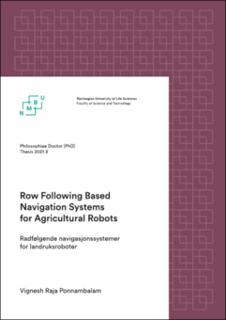| dc.contributor.advisor | Gjevestad, Jon Glenn Omholt | |
| dc.contributor.advisor | From, Pål Johan | |
| dc.contributor.author | Ponnambalam, Vignesh Raja | |
| dc.date.accessioned | 2023-09-29T08:14:26Z | |
| dc.date.available | 2023-09-29T08:14:26Z | |
| dc.date.issued | 2021 | |
| dc.identifier.isbn | 978-82-575-1781-6 | |
| dc.identifier.issn | 1894-6402 | |
| dc.identifier.uri | https://hdl.handle.net/11250/3092968 | |
| dc.description.abstract | The main goal of the thesis is to study methods to follow row-like structures
in agricultural scenarios by using low-cost hardware components to create an
environment-aware robotic system. The objective is not only to solve a particular
agricultural application, but the focus is to develop algorithms to understand
the environment by using different sensors and allowing a robot to calculate and
execute safe movement trajectories in any dynamically changing environment
where plants are organized in a row.
This thesis has developed an automatic crop row following system to perform
navigation in very tightly spaced polytunnels and in hilly strawberry fields. The
method to build a virtual barrier around the row-like structures allows the robot
to find safe trajectories throughout a dynamically changing environment. The
work eventually evolved in using deep learning approaches to recognize crop and
non-crop regions for automated guiding line estimation.
The thesis concludes that commercially available hardware can be integrated
using advanced algorithms to precisely follow the rows and make quick estimations
to adversely changing situations. A 2D Laser scanner, RTK-GNSS and 3D
cameras with the agricultural robot named “Thorvald”, were used to perform all
the experiments in real-world conditions. | en_US |
| dc.description.abstract | Hovedmålet med oppgaven er å følge radlignende strukturer i landbruket der man bruker billige maskinvarekomponenter for å lage et robotsystem som er bevisst på sine omgivelser. Målet er ikke bare å løse en bestemt landbruksapplikasjon, men fokuset er å utvikle algoritmer for å forstå omgivelsene ved å bruke kameraer og la roboten beregne og utføre baneplanlegging i et dynamisk miljø som er i endring.
Denne oppgaven har utviklet et radfølgende navigastionsystem i trange polytunneller og i kuperte jordbærfelt. Videre muliggjør metoden å bygge visuelle barrierer rundt radene slik at roboten finner trygge områder i et dynamisk miljø i endring. Arbeidet benytter dype læringsmetoder for å gjenkjenne rader med planter avlingsregioner for automatisk guidet linjeestimering.
Oppgaven konkluderer med at kommersielt tilgjengelig maskinvare kan integreres ved hjelp av avanserte algoritmer for nøyaktig å følge radene og gjøre raske estimater av dynamiske systemer. En 2D laserskanner, RTK-GNSS og 3D-kameraer ble brukt med landbruksroboten kalt “Thorvald” for å utføre forsøk under virkelige forhold. | en_US |
| dc.language.iso | eng | en_US |
| dc.publisher | Norwegian University of Life Sciences, Ås | en_US |
| dc.relation.ispartofseries | PhD Thesis;2021:3; | |
| dc.rights | Navngivelse-DelPåSammeVilkår 4.0 Internasjonal | * |
| dc.rights | Navngivelse 4.0 Internasjonal | * |
| dc.rights.uri | http://creativecommons.org/licenses/by/4.0/deed.no | * |
| dc.subject | Agricultural Robotics; Navigation; Vision; Crop Row Following | en_US |
| dc.title | Row following based navigation systems for agricultural robots | en_US |
| dc.title.alternative | Radfølgende navigasjonssystemer for landruksroboter | en_US |
| dc.type | Doctoral thesis | en_US |
| dc.description.version | publishedVersion | en_US |
| dc.subject.nsi | VDP::Technology: 500 | en_US |

